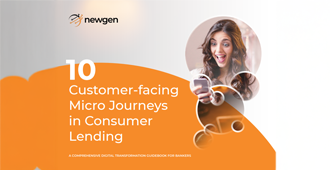How Technology Is Reshaping Lending
Consumer lending is no longer about processing volumes faster; it’s about building intelligence into every stage of the lifecycle. Traditional models, rigid scorecards, siloed workflows, and paper-heavy processes are increasingly inadequate in an AI-first financial system where borrowers expect instant responses, regulators demand explainability, and competitors innovate at ecosystem scale. Loan origination software (LOS) has become the strategic control layer for lenders. It is where compliance, customer experience, and credit risk converge. What follows are the key trends redefining this space not incremental digitization, but fundamental redesigns of how credit is assessed, delivered, and governed.
Trend 1: AI-powered Credit Decisioning
The next frontier in credit assessment isn’t just faster approvals, it’s fairer and more inclusive lending. Traditional bureau scores are blunt instruments in a world where millions of borrowers are creditworthy but invisible in legacy systems. Think of gig workers with irregular income, or first-time borrowers whose digital payment history says more about their reliability than their thin credit file ever could.
The shift is toward multi-dimensional risk assessment, where alternative data, digital wallets, transaction behavior, even recurring bill payment, is layered with traditional credit history. This expands the addressable lending market without increasing portfolio risk. Regulators, too, are moving toward demanding explainability: lenders must show not just the outcome of a decision, but the reasoning behind it.
How Newgen Makes the Difference: Newgen’s AI-first loan origination platform already incorporates decisioning frameworks that allow lenders to design and update risk models as markets evolve. Beyond automation, the platform supports the kind of transparency regulators are calling for, every rule, every data source, every approval step is traceable. That means lenders don’t just approve loans faster; they do it in a way that broadens access and builds regulatory resilience.
Trend 2: Digital Lending and End-to-end Automation
The industry is moving past “paperless processing” as a differentiator. In the near future, automation will be measured not by speed alone, but by adaptability. A fully automated lending flow that can’t flex when regulations shift, or when a new product needs to launch, becomes obsolete overnight.
The real competitive advantage is configurable automation: workflows that can adapt to new compliance rules, support emerging digital identity standards, and integrate with new distribution channels without rebuilding the system from scratch. This flexibility is what will separate tomorrow’s winners from today’s fast followers.
How Newgen Makes the Difference: Newgen’s LOS system is already enabling lenders to run lending as a series of configurable digital processes rather than hard-coded tasks. That means when new identity verification methods, regulatory changes, or partner ecosystems emerge, lenders don’t need to rip and replace, they adapt the process in weeks, not years. The result: automation that isn’t static, but alive to market shifts.
Trend 3: Cloud-based Loan Origination Platforms
The future of loan origination is agile, scalable, and modular. Traditional on-premise systems are rigid: adding new products, integrating third-party services, or scaling for seasonal spikes often requires months of IT projects and costly infrastructure upgrades. In an era where customer expectations evolve weekly and regulations shift rapidly, that delay is a competitive disadvantage.
Cloud-native LOS platforms are no longer just a cost-saving measure; they are strategic enablers of innovation. The real shift isn’t moving to the cloud; it’s how cloud architecture allows lenders to experiment, iterate, and launch new credit products faster than ever before. For example, lenders can deploy micro-loans, flexible repayment schemes, or embedded financing offerings without overhauling their core systems.
Security and compliance also become manageable at scale. Cloud-native systems enable centralized monitoring, automated audit trails, and near real-time regulatory reporting, critical as lenders extend credit across multiple channels and partners.
How Newgen Makes the Difference: Newgen’s cloud-native LOS solution is already helping lenders operate with this level of flexibility. Its modular architecture allows workflows, product configurations, and integrations to be updated on the fly, without disrupting ongoing operations. Lenders can plug in new third-party data sources, connect to partner marketplaces, or scale capacity during demand surges, all while maintaining compliance and data integrity.
Trend 4: API-driven Lending Ecosystems
Lending is no longer confined to a bank’s own channels. Borrowers encounter credit in apps, marketplaces, and digital services, often before they think about a traditional loan. To compete, lenders must become platforms, not just product providers. The key enabler is a robust API ecosystem, secure, modular, and flexible.
APIs allow lending services to integrate seamlessly with third-party applications, enabling real-time loan offers, point-of-sale financing, and co-lending arrangements. But beyond connectivity, the real value lies in controlling the experience and the data flow. Lenders can maintain oversight of risk, compliance, and customer interaction while reaching borrowers wherever they transact. Those who fail to adopt API-first models risk being left out of emerging digital ecosystems.
How Newgen Makes the Difference: Newgen’s LOS platform is designed to operate as an open, API-first platform. Lenders can expose or consume services securely, enabling point-of-sale lending, marketplace integrations, and partnerships with digital platforms without lengthy custom development. Each integration respects compliance, maintains data integrity, and allows the lender to manage risk centrally.
Trend 5: Embedded Finance in Consumer Lending
Credit is moving to the places where consumers already spend their time, rather than waiting for borrowers to seek it out. Lending is being embedded into digital experiences, e-commerce platforms, service apps, and point-of-sale systems, turning financial services into a seamless part of everyday transactions.
The opportunity goes beyond convenience. Embedded finance allows lenders to deliver contextually relevant credit, offering the right product at the right moment, with repayment terms tailored to the purchase or service. This approach drives higher conversion, better customer engagement, and deeper data insights into borrower behavior. The challenge is doing this without compromising compliance, operational control, or user experience.
How Newgen Makes the Difference: Newgen’s loan origination platform enables lenders to deploy embedded lending across multiple digital touchpoints. It supports configurable product rules, real-time decisioning, and integration with partner ecosystems, ensuring that credit offers appear where and when they are most relevant. Lenders retain full visibility into risk and compliance, while consumers experience a frictionless, integrated journey
Trend 6: Compliance and Security Enhancements
As lending shifts deeper into digital channels, compliance and security are no longer back-office concerns; they are central to operational resilience and customer trust. Regulators worldwide are demanding faster, more auditable processes, while borrowers expect that their personal and financial data is handled securely at every stage.
The challenge is twofold: keeping pace with evolving regulations and protecting against increasingly sophisticated threats, from identity fraud to cyberattacks. Manual compliance checks or fragmented security systems are no longer sufficient. The next generation of loan origination platforms must embed compliance and security into every workflow, ensuring that risk management scales alongside lending operations.
How Newgen Makes the Difference: Newgen’s LOS system integrates compliance and security at the core of its workflows. Automated KYC/AML checks, audit trails, and real-time monitoring allow lenders to stay ahead of regulatory changes without slowing down approvals. Security measures, including data encryption, access control, and anomaly detection, are built into the platform, safeguarding both the lender and the borrower. By unifying compliance and operational efficiency, Newgen enables institutions to grow lending volumes with confidence, knowing that regulatory and security obligations are proactively managed.
Trend 7: Customer-centric Experiences in Loan Origination
Modern borrowers are no longer satisfied with basic approval timelines; they expect clarity, transparency, and hyper-personalized solutions. Customer experience has become a key differentiator in lending, institutions that fail to anticipate needs, communicate clearly, or offer flexible repayment options risk losing both trust and market share.
The emerging focus is on data-driven personalization that goes beyond simple targeting. Insights from borrower behavior, transaction patterns, and engagement history allow lenders to offer the
right product, at the right time, with terms that feel tailored and fair. Speed remains critical, but so does predictability: borrowers want to know exactly what to expect at each step of the journey.
How Newgen Makes the Difference: NewgenONE AI/ML Data Science Studio integrates with the loan origination system which enables lenders to embed customer-centricity into every workflow. Through intelligent data orchestration, configurable lending products, and proactive notifications, lenders can create experiences that feel seamless and personalized without compromising compliance or operational efficiency. By aligning product offerings with individual borrower needs and preferences, Newgen helps financial institutions strengthen loyalty, reduce friction, and maintain competitive advantage in a market where customer expectations evolve constantly.
Conclusion:
The landscape of loan origination is evolving rapidly. Lenders who adopt intelligent decisioning, flexible automation, cloud-native platforms, API-driven ecosystems, embedded finance, robust compliance, and customer-centric approaches will stay ahead of market demands. Platforms like Newgen make these capabilities actionable, enabling lenders to deliver faster, smarter, and more personalized credit experiences while maintaining control, security, and regulatory compliance.
You might be interested in


15 Jan, 2025
2025 and Beyond: How AI is Reshaping Digital Lending in Banking & Financial Services


